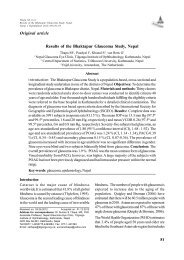nepjoph 2012.pmd - Nepalese Journal of Ophthalmology
nepjoph 2012.pmd - Nepalese Journal of Ophthalmology
nepjoph 2012.pmd - Nepalese Journal of Ophthalmology
Create successful ePaper yourself
Turn your PDF publications into a flip-book with our unique Google optimized e-Paper software.
Dada T et al<br />
Trypan blue staining <strong>of</strong> filtering bleb<br />
Nepal J Ophthalmol 2012; 4(8):224-229<br />
subconjunctival fibrosis, prevent bleb failure, and<br />
achieve better intraocular pressure control (Parrish<br />
et al 2001, Chen et al 1990).<br />
Knowing whether the bleb is patent and functional<br />
has important implications in the management <strong>of</strong><br />
glaucoma cases. The aqueous drainage through the<br />
filtration bleb cannot be accurately quantified. Many<br />
authors (Pitch et al 1998, Clarke et al 2003) have<br />
investigated morphological criteria <strong>of</strong> these blebs<br />
to correlate clinical and functional aspects. Although<br />
some authors have described the evaluation <strong>of</strong><br />
filtering bleb by thermography (Kawasaki et al<br />
2009) and in vivo confocal microscopy (Messmer<br />
et al 2006, Labbe et al 2005), there is still a lack <strong>of</strong><br />
clinical tests that can objectively delineate the<br />
functional status <strong>of</strong> the bleb.<br />
The diffusion <strong>of</strong> trypan blue dye into the filtration<br />
bleb following its instillation into the anterior chamber<br />
has already been documented (Agrawal et al 2005).<br />
However to the best <strong>of</strong> our knowledge, no study in<br />
literature has classified the diffusion patterns <strong>of</strong> the<br />
dye during phacoemulsification surgery and<br />
correlated it with bleb function.<br />
In this clinical study, patients with previously<br />
operated trabeculectomy undergoing cataract<br />
surgery were evaluated. The staining patterns <strong>of</strong> the<br />
blebs obtained after trypan blue injection into the<br />
anterior chamber were analyzed and correlated to<br />
the mean IOP recorded before the cataract surgery<br />
in order to evaluate the functioning <strong>of</strong> the bleb.<br />
Subjects and methods<br />
This retrospective charts review was carried out<br />
on 33 eyes <strong>of</strong> 33 patients recruited from the followup<br />
cases attending the glaucoma clinic at our centre<br />
between October 2007 and December 2009.<br />
Patients with a previously operated trabeculectomy<br />
with mitomycin C, having a visually significant<br />
cataract with a best corrected visual acuity <strong>of</strong> 20/<br />
40 or less, and presenting at least 6 months or more<br />
after trabeculectomy were included in the study.<br />
Patients with corneal opacities, severe dry eye,<br />
uveitis, and previous ocular surgery other than<br />
trabeculectomy were excluded.<br />
The pre-operative evaluation included a detailed<br />
ophthalmic history and clinical examination <strong>of</strong> all<br />
eyes. This included near and distant best corrected<br />
visual acuity, Goldmann applanation tonometry, slit<br />
lamp evaluation <strong>of</strong> the bleb, gonioscopy, optic nerve<br />
head evaluation with a + 90 diopter lens, and ocular<br />
biometry. The study conformed to the Declaration<br />
<strong>of</strong> Helsinki, and informed written consent was<br />
obtained from all patients. All patients were assigned<br />
to undergo phacoemulsification with intraocular lens<br />
implantation by a single surgeon (TD). Maximum<br />
mydriasis was obtained by a combination <strong>of</strong><br />
tropicamide 0.5% and phenylepherine 0.5% applied<br />
three times at ten minute intervals preoperatively.<br />
All surgeries were performed under either topical<br />
anaesthesia using sterile 0.5% proparacaine drops<br />
(Paracain, Sunways, Mumbai, India).<br />
All patients underwent a clear corneal<br />
phacoemulsification via a temporal incision <strong>of</strong> size<br />
2.75 mm along with a superior side port incision.<br />
The anterior chamber was reformed with air and<br />
0.1 ml <strong>of</strong> trypan blue dye (0.06%, Visiblue, Shah<br />
and Shah, India) was injected under the air bubble<br />
to stain the anterior capsule using a 27 G cannula.<br />
Capsulorrhexis was performed under viscoelastics<br />
cover (1 % hydroxypropylmethylcellulose).<br />
Phacoemulsification was completed by the stop and<br />
chop technique followed by implantation <strong>of</strong> a<br />
hydrophobic acrylic foldable intraocular lens in the<br />
bag. The filtering bleb was observed for trypan<br />
blue staining and graded. The grading for the staining<br />
pattern <strong>of</strong> the bleb was as follows: Group 1 no<br />
staining, Group 2 minimal staining, Group 3 patchy<br />
staining, and Group 4 diffuse staining (Fig. 1-4).<br />
Post operatively the patient received gatifloxacin<br />
0.3%, prednisolone acetate 1% four times a day<br />
which were tapered over four weeks. If the patient<br />
was receiving ocular hypotensive medications in the<br />
pre-operative period, these were continued<br />
postoperatively.<br />
Statistics: Statistical analyses were performed<br />
using SPSS (version 12.0, SPSS Inc, Chicago, IL).<br />
Fischer’s Analysis <strong>of</strong> Variation (one way ANOVA),<br />
225




